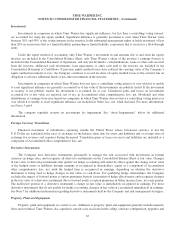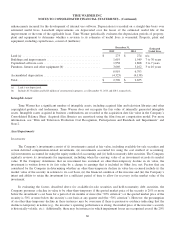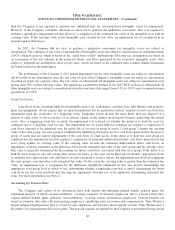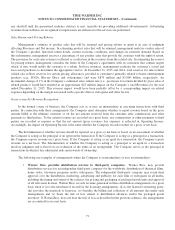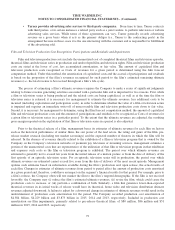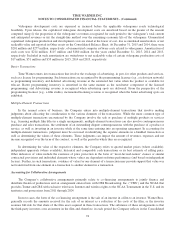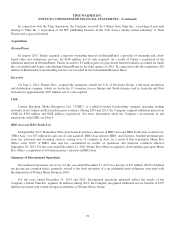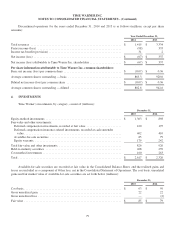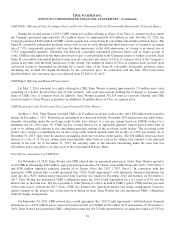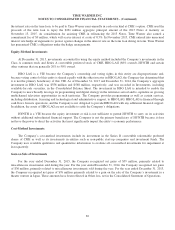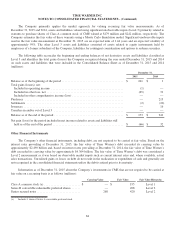Time Magazine 2015 Annual Report Download - page 89
Download and view the complete annual report
Please find page 89 of the 2015 Time Magazine annual report below. You can navigate through the pages in the report by either clicking on the pages listed below, or by using the keyword search tool below to find specific information within the annual report.TIME WARNER INC.
NOTES TO CONSOLIDATED FINANCIAL STATEMENTS - (Continued)
Statement of Operations either a charge or benefit to Costs of revenues to reflect the estimate of the third-party investor’s
interest in the profits or losses incurred on the film. The estimate of the third-party investor’s interest in profits or losses
incurred on the film is determined using the film forecast computation method. For the years ended December 31, 2015,
2014 and 2013, net participation costs related to third party investors of $406 million, $580 million and $522 million,
respectively, were recorded in Costs of revenues.
The aggregate programming rights fee, production costs, advertising revenues and sponsorship revenues related to the
NCAA Tournament and related programming are equally shared by Turner and CBS. However, if the amount paid for the
programming rights fee and production costs in any given year exceeds advertising and sponsorship revenues for that year,
CBS’ share of such shortfall is limited to specified annual amounts (the “loss cap”), ranging from approximately $90 million
to $30 million. The amounts incurred by the Company pursuant to the loss cap during the years ended December 31, 2015
and 2014 were not significant. In accounting for this arrangement, the Company records Advertising revenues for the
advertisements aired on Turner’s networks and amortizes Turner’s share of the programming rights fee based on the ratio of
current period advertising revenues to its estimate of total advertising revenues over the term of the arrangement.
Advertising Costs
Time Warner expenses advertising costs as they are incurred, which generally is when the advertising is exhibited or
aired. Advertising expense to third parties was $2.586 billion in 2015, $2.430 billion in 2014 and $2.447 billion in 2013.
Income Taxes
Income taxes are provided using the asset and liability method, such that income taxes (i.e., deferred tax assets,
deferred tax liabilities, taxes currently payable/refunds receivable and tax expense) are recorded based on amounts
refundable or payable in the current year and include the results of any difference between GAAP and tax reporting. Deferred
income taxes reflect the tax effect of net operating losses, capital losses and tax credit carryforwards and the net tax effects of
temporary differences between the carrying amount of assets and liabilities for financial statement and income tax purposes,
as determined under tax laws and rates. Valuation allowances are established when management determines that it is more
likely than not that some portion or all of the deferred tax asset will not be realized. The financial effect of changes in tax
laws or rates is accounted for in the period of enactment. The subsequent realization of net operating loss and general
business credit carryforwards acquired in acquisitions accounted for using the purchase method of accounting is recognized
in the Consolidated Statement of Operations. Tax credits received for the production of a film or program are offset against
the cost of inventory capitalized. Deferred tax assets are included in Other assets in the Consolidated Balance Sheet.
From time to time, the Company engages in transactions in which the tax consequences may be subject to uncertainty.
Examples of such transactions include business acquisitions and dispositions, including dispositions designed to be tax free,
and certain financing transactions. Significant judgment is required in assessing and estimating the tax consequences of these
transactions. The Company prepares and files tax returns based on its interpretation of tax laws and regulations. In the normal
course of business, the Company’s tax returns are subject to examination by various taxing authorities. Such examinations
may result in future tax and interest assessments by these taxing authorities. In determining the Company’s tax provision for
financial reporting purposes, the Company establishes a reserve for uncertain tax positions unless such positions are
determined to be more likely than not of being sustained upon examination based on their technical merits. There is
considerable judgment involved in determining whether positions taken on the Company’s tax returns are more likely than
not of being sustained.
The Company adjusts its tax reserve estimates periodically because of ongoing examinations by, and settlements with,
the various taxing authorities, as well as changes in tax laws, regulations and interpretations. The Company’s policy is to
recognize, when applicable, interest and penalties on uncertain tax positions as part of income tax expense. For further
information, see Note 9.
75


